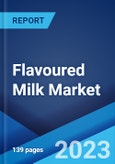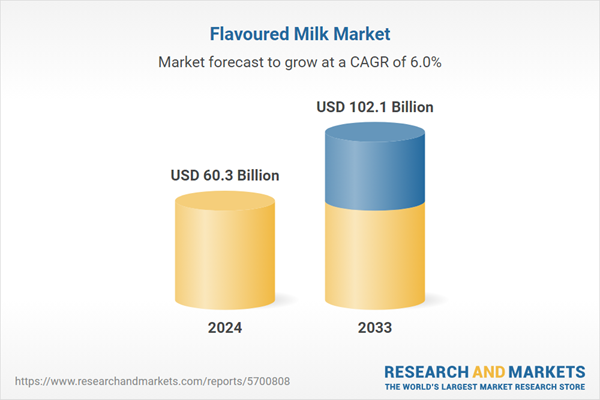Flavoured milk, commonly denoted as milk infused with diverse natural or artificial flavors, stands as a widely embraced beverage across the globe. It is enhanced with various flavors and sweeteners to make it more palatable and appealing to consumers. Common flavors of flavored milk include chocolate, strawberry, vanilla, and caramel, among others. These flavors are usually added in the form of syrups, powders, or natural extracts to give the milk a distinctive taste. Flavoured milk is widely consumed among children, as it provides the nutritional benefits of milk while offering a more enjoyable taste.
The global flavoured milk market is influenced by the rising health consciousness, which has prompted consumers to opt for fortified flavoured milk with added vitamins and minerals. Moreover, innovative packaging designs by key players to enhance shelf appeal is favoring the market growth. Furthermore, advancements in distribution channels, especially in e-commerce, have expanded market reach. This is further supported by the introduction of diverse flavors catering to regional tastes. In line with this, aggressive marketing campaigns by key players focusing on the nutritional benefits of flavoured milk compared to sugary beverages is propelling the market growth.
Additionally, the growing preference for on-the-go breakfast solutions and increasing disposable income are providing a positive outlook for the market. Apart from this, collaborations between dairy producers and other industries, such as the confectionery sector, and research and development (R&D) activities in the dairy sector aiming are fueling the market growth.
Flavoured Milk Market Trends/Drivers:
Growing health consciousness among consumers
In recent years, there has been a noticeable global trend toward greater health consciousness. Consumers are now more discerning about the nutritional content of their food and beverages (F&B), seeking products that deliver both flavor and health benefits. To meet this demand, flavoured milk producers have strategically fortified their offerings with essential vitamins and minerals, such as Vitamin D, calcium, and iron. This fortification not only elevates the nutritional value of flavoured milk but also resonates with health-conscious consumers seeking better beverage options. Consequently, fortified flavoured milk has gained prominence as a beverage that harmoniously combines taste, refreshment, and nutrition, particularly appealing to the younger demographic.Innovative packaging strategies by key players
Packaging plays an integral role in shaping consumer purchasing decisions, particularly within the fast-moving consumer goods (FMCG) sector. In the flavoured milk market, innovative packaging serves multiple purposes. Beyond ensuring product safety and extending shelf life, it significantly elevates product attractiveness on store shelves. Producers are investing in ergonomic designs, eye-catching graphics, and environmentally sustainable materials to differentiate their products. Some brands have introduced resealable caps, single-serving sizes, and even transparent sections to showcase product consistency and quality. These packaging innovations not only enhance aesthetics but also offer practical benefits while aligning with sustainability objectives, resonating particularly with eco-conscious consumers.E-commerce revolutionizing distribution channels
The digital transformation has brought about profound changes in consumer shopping habits. E-commerce platforms have emerged as dominant forces in the retail landscape, offering unparalleled convenience and product variety. Within the flavoured milk market, these platforms have assumed pivotal roles as distribution channels. Producers are forging strategic partnerships with e-commerce giants to ensure broader market reach, especially in regions where traditional retail may have limitations.Additionally, digital platforms provide a direct avenue for brands to engage with consumers, collect valuable feedback, and even introduce exclusive online product offerings. The e-commerce revolution ensures that flavoured milk products are just a click away for consumers, resulting in increased sales and heightened brand visibility in a competitive market environment.
Flavoured Milk Industry Segmentation:
The research provides an analysis of the key trends in each segment of the market, along with forecasts at the global and regional levels from 2025-2033. Our report has categorized the market based on flavour, packaging and distribution channel.Breakup by Flavour:
- Chocolate
- Fruit
- Vanilla
- Other.
Chocolate dominates the market
A detailed breakup and analysis of the market based on the flavour has also been provided in the report. This includes chocolate, fruit, vanilla, and others. According to the report, chocolate represented the largest segment.Chocolate-flavored milk offers a satisfying and comforting sensory experience, making it a preferred choice among consumers. Moreover, the increasing awareness of potential health benefits associated with dark chocolate, such as antioxidants and mood-enhancing properties, has prompted consumers to opt for chocolate-flavored milk as a more nutritious indulgence. In line with this, manufacturers have demonstrated agility by introducing innovations such as chocolate-flavored milk with added protein or reduced sugar options to cater to health-conscious consumers.
Furthermore, the enduring popularity of chocolate in various dessert and beverage forms ensures its consistent demand within the flavoured milk market. Apart from this, effective marketing strategies that evoke nostalgia, emphasize premium ingredient quality, and highlight the soothing attributes of chocolate contribute significantly to its sustained growth and dominance in this segment.
Breakup by Packaging:
- Paper Based
- Plastic Based
- Glass Based
- Metal Based
The paper-based packaging segment in the flavoured milk market is driven primarily by its eco-friendly appeal. Consumers are increasingly drawn to sustainable options, and paper-based cartons align with this preference. Additionally, the convenience of resealable paper-based containers and the ease of recycling contribute to its popularity. The plastic-based packaging segment thrives due to its durability and cost-effectiveness. Plastic containers offer excellent protection for flavoured milk, ensuring product integrity during transportation and on store shelves. The segment is driven by the perception of glass as a high-quality, recyclable material that preserves the flavor and freshness of flavoured milk.
The metal-based packaging segment gains traction primarily due to its exceptional product protection and extended shelf life. Metal cans provide a robust barrier against external elements, maintaining the quality of flavoured milk. The segment is driven by a combination of product protection, sustainability, and suitability for long shelf life, making it a choice for brands focused on these attributes in the flavoured milk market.
Breakup by Distribution Channel:
- Supermarkets and Hypermarkets
- Convenience Stores
- Specialty Stores
- Online Stores
- Other.
Supermarkets and hypermarkets dominate the market
A detailed breakup and analysis of the market based on the distribution channel has also been provided in the report. This includes supermarkets and hypermarkets, convenience stores, specialty stores, online stores, and others. According to the report, supermarkets and hypermarkets represented the largest segment.The supermarkets and hypermarkets segment dominates the flavoured milk market as these large retail outlets offer a wide range of flavoured milk products under one roof, providing consumers with convenience and choice, which is particularly appealing to busy urban populations. In line with this, the ability to stock and display a diverse array of flavoured milk brands and flavors fosters competition, driving innovation and product development within the market. Additionally, supermarkets and hypermarkets often employ strategic placement and attractive promotions, increasing consumer exposure and encouraging purchases.
Moreover, their efficient supply chain management and robust inventory systems ensure consistent product availability, reducing stockouts and thereby enhancing customer loyalty. Besides this, these retail giants can leverage economies of scale, negotiating better deals with suppliers and passing on cost savings to consumers, making flavoured milk more affordable and attractive.
Breakup by Region:
- Asia Pacific
- North America
- Latin America
- Western Europe
- Africa
- Eastern Europ.
Asia Pacific exhibits a clear dominance, accounting for the largest flavoured milk market share
The market research report has also provided a comprehensive analysis of all the major regional markets, which include Asia Pacific, North America, Latin America, Western Europe, Africa, and Eastern Europe. According to the report, Asia Pacific represented the largest segment.The Asia Pacific region is experiencing significant growth in the flavoured milk market, driven by the shifting consumer preferences towards healthier beverage options, combined with rising disposable incomes. Consumers in the region are increasingly health-conscious and seek products that offer both taste and nutritional benefits. Moreover, the vast and diverse population in Asia Pacific presents a substantial market opportunity. Manufacturers are tailoring their offerings to cater to diverse flavor preferences and regional tastes, thereby expanding their customer base.
In line with this, the expansion of modern retail channels, including supermarkets, hypermarkets, and convenience stores, has improved accessibility to flavoured milk products. Furthermore, aggressive marketing and promotional activities by major players in the region have created heightened awareness and brand loyalty among consumers. Apart from this, innovative packaging designs and eco-friendly materials are enhancing product visibility and appeal, further driving the growth of the flavoured milk market in the Asia Pacific region.
Competitive Landscape:
The competitive landscape of the flavoured milk market is marked by intense rivalry and dynamic factors that shape the industry. Key market players continuously strive to gain a competitive edge through innovation, product differentiation, and market expansion strategies. Product innovation, particularly in flavors and packaging, remains a focal point, as companies seek to cater to diverse consumer preferences. Moreover, marketing campaigns emphasizing the nutritional benefits of flavoured milk and its superiority over sugary alternatives play a pivotal role in brand positioning.Supply chain efficiency and distribution networks are critical in ensuring product availability and maintaining market share. The emergence of e-commerce as a significant distribution channel has further intensified competition, with companies vying to establish a robust online presence. Sustainable and eco-friendly packaging solutions are also becoming increasingly important in response to consumer demand for environmentally responsible products.
The market research report has provided a comprehensive analysis of the competitive landscape. Detailed profiles of all major companies have also been provided. Some of the key players in the market include:
- Nestle S.A.
- Danone S.A.
- Arla Foods amba
- Yili Industrial Group Co. Ltd.
- Dairy Farmers of America, Inc.
- China Mengniu Dairy Co., Ltd.
Key Questions Answered in This Report
- What was the size of the global flavoured milk market in 2024?
- What is the expected growth rate of the global flavoured milk market during 2025-2033?
- What has been the impact of COVID-19 on the global flavoured milk market?
- What are the key factors driving the global flavoured milk market?
- What is the breakup of the global flavoured milk market based on the flavour?
- What is the breakup of the global flavoured milk market based on the distribution channel?
- What are the key regions in the global flavoured milk market?
- Who are the key players/companies in the global flavoured milk market?
Table of Contents
Companies Mentioned
- Nestle S.A.
- Danone S.A.
- Arla Foods amba
- Yili Industrial Group Co. Ltd.
- Dairy Farmers of America Inc.
- China Mengniu Dairy Co. Ltd
Table Information
| Report Attribute | Details |
|---|---|
| No. of Pages | 135 |
| Published | June 2025 |
| Forecast Period | 2024 - 2033 |
| Estimated Market Value ( USD | $ 60.3 Billion |
| Forecasted Market Value ( USD | $ 102.1 Billion |
| Compound Annual Growth Rate | 6.0% |
| Regions Covered | Global |
| No. of Companies Mentioned | 6 |









